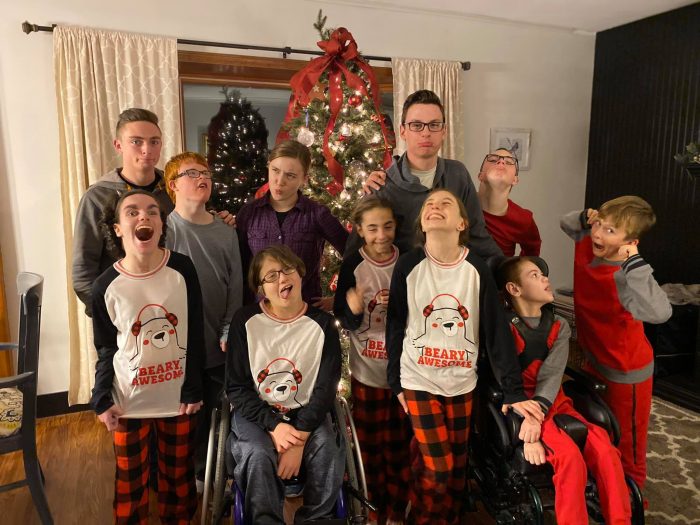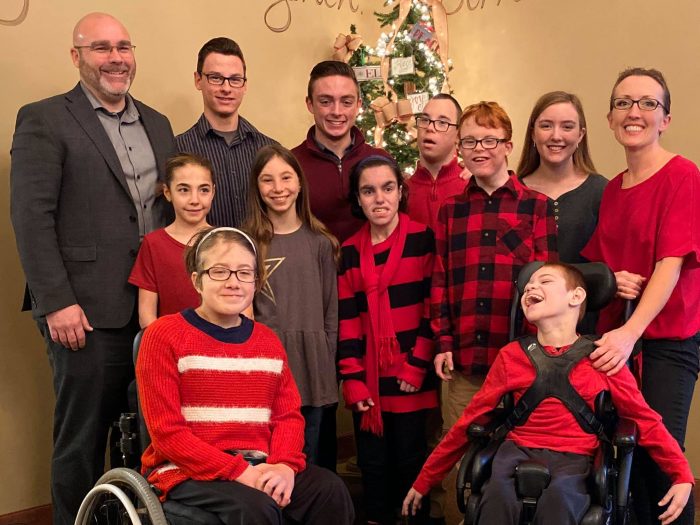There is currently a shortage of people willing to become foster parents, and children are placed into the system without enough people to care for them. These children often come from traumatic backgrounds; their parents have died, been declared unfit, have abandoned them, or are incarcerated. Because so few homes are available, some of these children must be housed in juvenile detention centers, shelters, and group homes. But Sean and Jill Martin wanted to be one of the few couples willing to give these kids a home.
The Martins spoke to Live Action News about their journey to becoming foster parents, which resulted in them adopting 9 children from foster care. With their two biological children, that gave them an incredible total of 11 kids. “We grew up in a time when not everyone who was adopted always knew they were adopted,” Sean Martin explained. “At some point when they got older, often in their early teen years, their parents would tell them they were adopted. This was true for a couple of Jill’s friends. When this happened, it stuck with her and from that point on she wanted to adopt.”
Initially, though, Sean didn’t want any part in adoption. He had seen the traumatic outcomes those adoption scenarios caused, but Jill refused to give up. “When we knew we would get married, Jill asked me to pray about adoption and talk to a couple of friends that we knew at that time who were adopted and maybe had a different experience,” he said. “Over time, the Lord began to change me on the issue. By the time we got married, adoption was a part of the plan. As we learned more about adoption and all of the different types of adoption, we focused on kids who had special needs who were in the foster system. Who was going to adopt them? We knew we would.”
Children who aren’t placed into foster homes to be reunified with their parents, or who aren’t adopted by their foster parents, often don’t fare well, and for understandable reasons — they’re often left to try to survive in horrible situations.
Seven in 10 foster children in West Virginia, for example, live in group homes, detention centers, and residential treatment facilities. According to the federal Children’s Bureau, 14 percent of the national foster child population resides in these kinds of institutions—and unsurprisingly, it has destructive results. According to one study, for example, more than half of foster children who aged out of the system in the Midwest ended up arrested, jailed, or convicted. Other statistics are similarly grim; 20% of foster children are homeless the moment they turn 18 and age out of the system. Half will not find gainful employment by the time they reach their 20s, and roughly 70% of female foster children become pregnant before they reach the age of 21. Virtually none of the foster children who age out of the system receive college degrees.
“We are just destroying these kids,” Marcia Lowry, executive director of A Better Childhood (ABC), told the Washington Post. “They’re warehoused into emergency shelters, out-of-state institutions and juvenile detention centers, which can cause lifelong emotional trauma — their childhoods spent segregated from the outside world.”
READ: Eight myths and misunderstandings about foster care… and the truth
The Martins were willing to step up and give some of these children the home they needed. Adoption was always part of their plan. “We are learners, so we started by learning everything we could about adoption,” Sean said. “That was a couple-year process before we actually started to look at adopting ourselves. We read books, we talked to families, we attended classes and learned all we could about all the various ways we could adopt.”
They were able to eventually foster and adopt 11 children, though a few children they were supposed to care for fell through before placement was able to happen. And helping their kids through their trauma was difficult. “Children who have experienced trauma don’t respond to love and affection in the way you would expect. They repel it,” he said. “Since they have not experienced love and affection, they don’t trust it. They expect to be hurt again. They test and respond with anger, outbursts or by sabotaging any special event, especially if it’s for them.”
These issues are common in foster children, with the behaviors stemming from their attachment issues and instability in their lives. Yet with time, their kids began to heal. “Often it feels like Groundhog Day, the same thing over and over without any change, any growth, any healing,” he said. “But then looking back over years, you do see growth and healing.”
The goal of foster care is to eventually reunite children with their parents, and if that isn’t possible, that’s when adoption becomes an option. And it’s not easy, even with all the love someone may have to offer.
“I think [one] misconception about kids in the system is ‘All they need is love,'” Sean said. “That is absolutely false. They need healing. They need stability. They need structure. Just loving them and not addressing their issues will not help them. In the long run it will hurt them.”
And with the right help, these children are able to heal and thrive from the trauma and pain they’ve experienced. “As our kids get older, they are beginning to look at their lives differently. They know their lives are not perfect with us, but they also know that their lives could have been much different,” Sean said. “They are grateful and have expressed that. We have also seen our kids overcome obstacles that they thought were impossible. We have seen healing from trauma begin to happen and glimpses of joy in their lives.”
Many people may be intimidated by the idea of taking in children perceived as damaged or broken — but it can be incredibly rewarding and fulfilling to do so. And the Martins encouraged those who are hesitant to face their fears head-on and try anyway.
“So many say they have thought about it but the timing wasn’t right. Maybe someday,” Sean said. “Someday will never come. Do it. There are over 400,000 kids in the system and they need solid Christian homes to show them something different than what they have experienced. They need to see hope. They need to experience love. They need to have a place to heal. And if you feel unqualified, good! Then you can rely on God’s grace and strength and not your own. When you are weak He is strong.”
If you’re interested in or want more information about becoming a foster parent, visit the National Foster Parent Association.
Editor’s Note, 5/18/20: This article incorrectly listed the number of children the Martins adopted. This has been corrected.
“Like” Live Action News on Facebook for more pro-life news and commentary!









